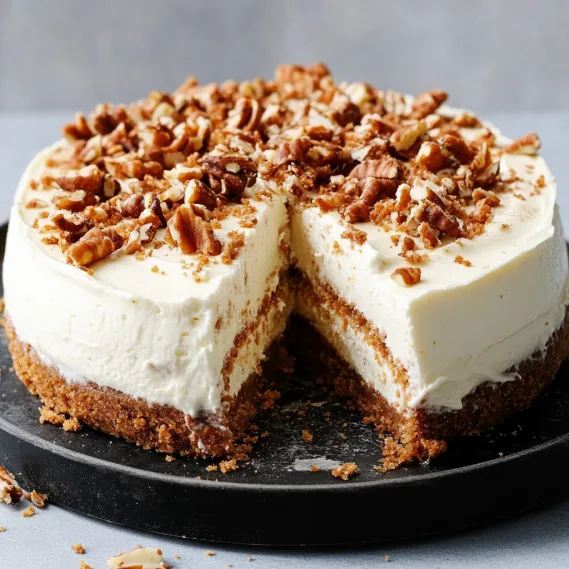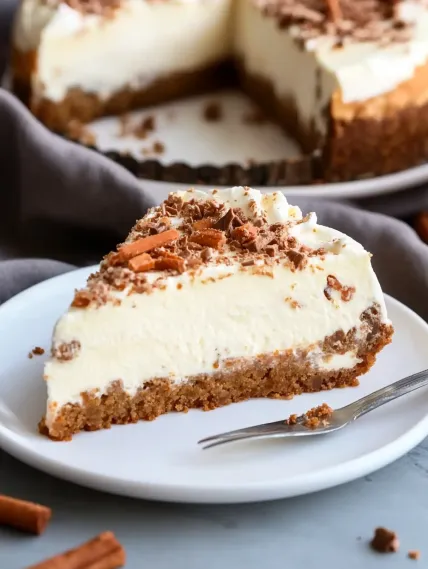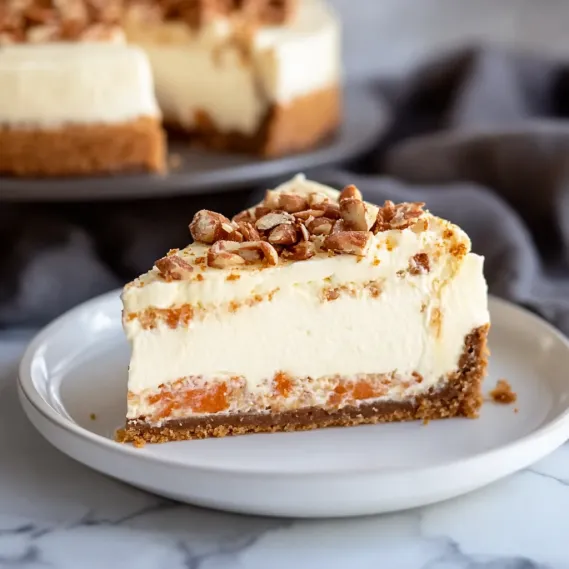 Pin
Pin
Two beloved desserts merge into one spectacular creation in this Carrot Cake Cheesecake. The rich creaminess of classic cheesecake beautifully complements the warm spices and tender texture of carrot cake, creating a showstopper dessert that's perfect for special occasions. Each bite delivers the perfect balance of tangy cream cheese, sweet carrots, and warm spices, all crowned with a luscious cream cheese frosting. This impressive dessert combines the best elements of two classic favorites without compromising either one – truly offering the best of both worlds in every slice.
Last Easter, I brought this to our family gathering and watched as everyone's eyes widened when I cut the first slice, revealing the beautiful layers inside. Even my uncle, who claimed to dislike both carrot cake and cheesecake individually, came back for a second piece. That's the magic of this combination – it transforms both desserts into something even more delicious than the sum of its parts.

Essential Ingredients and Selection Tips
- Cream Cheese: Use full-fat blocks of cream cheese at room temperature for the smoothest texture. The blocks perform much better than cream cheese spread for baking
- Carrots: Finely shred fresh carrots using the small holes of a box grater. Pre-shredded store carrots are typically too thick and won't soften properly during baking
- Spices: Fresh ground cinnamon and nutmeg make a noticeable difference in the flavor of the carrot cake layer. Check your spice cabinet and replace any that have been sitting for more than six months
- Sour Cream: Adds moisture and tanginess to both the cheesecake batter and frosting. Full-fat version works best for richness and texture

The quality of your ingredients truly matters in this recipe. When I upgraded from pre-ground spices to freshly ground cinnamon and nutmeg, the aroma and flavor of the carrot cake layer improved dramatically, creating an even more impressive final dessert.
Detailed Cooking Instructions
- Step 1: Prepare the Cheesecake Batter
- Bring cream cheese to room temperature by leaving it out for at least an hour before beginning. Beat 24 ounces (three blocks) of cream cheese and 3/4 cup granulated sugar together until completely smooth with no lumps. Add 3 large eggs one at a time, beating well after each addition. Stir in 1 tablespoon of flour, 1 teaspoon vanilla extract, and 1/4 cup sour cream, mixing just until combined and smooth.
- Step 2: Create the Carrot Cake Batter
- In a large bowl, whisk together 2 cups flour, 1 cup sugar, 1 teaspoon baking soda, 1 teaspoon cinnamon, and 1/2 teaspoon each of salt and nutmeg. Add 3/4 cup vegetable oil, 3 eggs, and 1 teaspoon vanilla, stirring until smooth. Fold in 2 cups finely shredded carrots (about 3-4 medium carrots) and 1/2 cup chopped pecans or walnuts if desired, stirring just until evenly distributed.
- Step 3: Layer the Batters for Baking
- Grease a 10-inch springform pan and wrap the outside with foil to prevent leaking. Spread half the carrot cake batter in the bottom of the pan, then dollop half the cheesecake batter on top without swirling. Repeat with remaining carrot cake batter, then spread the last of the cheesecake batter on top, keeping the layers distinct rather than mixing them together.
- Step 4: Bake and Cool Properly
- Bake at 350°F for 60-70 minutes until the edges are set but the center still has a slight jiggle. Turn off the oven, prop the door open slightly, and let the cheesecake cool in the oven for 1 hour. Remove from oven and cool completely at room temperature before refrigerating for at least 4 hours or overnight to allow the cheesecake to fully set.
- Step 5: Frost and Garnish
- Beat 8 ounces softened cream cheese with 1/4 cup butter until smooth, then add 2 cups powdered sugar and 1 teaspoon vanilla. Spread the frosting over the completely cooled cheesecake, then immediately garnish the edges with toasted chopped pecans if desired. Refrigerate until ready to serve, allowing the cake to sit at room temperature for 20-30 minutes before slicing.
My first attempt at this recipe taught me an important lesson about patience. I rushed the cooling process and ended up with a massive crack down the center. Now I always allow the cheesecake to cool gradually in the oven with the door propped open, which prevents those dramatic temperature changes that cause cracks. Thankfully, even if cracks appear, the cream cheese frosting covers any imperfections beautifully.
Serving Inspiration
This Carrot Cake Cheesecake makes a stunning centerpiece for holiday gatherings, especially Easter celebrations when carrot-themed desserts are traditional. For the most beautiful presentation, serve slices on dessert plates with a small dollop of additional frosting and a decorative carrot made from tinted marzipan. When serving at dinner parties, consider adding a light drizzle of caramel sauce across the plate for an elegant restaurant-style presentation.
Make-Ahead Tips
One of the best features of this dessert is how well it works for advance preparation. The cheesecake actually improves after 24 hours in the refrigerator as the flavors meld together. It can be made up to three days ahead and kept refrigerated, making it perfect for entertaining when you want to minimize day-of preparation. The entire cake can also be frozen (without frosting) for up to a month – simply thaw overnight in the refrigerator and add the frosting before serving.

Seasonal Adaptations
While classic carrot cake is perfect year-round, you can easily customize this recipe for different seasons. For autumn gatherings, add a teaspoon of pumpkin pie spice to the carrot cake batter and garnish with pepitas instead of pecans. During winter holidays, incorporate a teaspoon of orange zest into both batters and decorate with sugared cranberries for a festive touch. For summer celebrations, consider adding crushed pineapple (well-drained) to the carrot cake layer for a tropical twist.
This Carrot Cake Cheesecake has become my signature dessert for good reason. It combines the comforting, spiced warmth of carrot cake with the luxurious creaminess of cheesecake in perfect harmony. While it might look complicated, the straightforward layering process makes it achievable for any home baker willing to follow the steps carefully. The result is a truly unforgettable dessert that will have everyone requesting the recipe and asking when you'll make it again.
Recipe FAQs
- → Can I make this carrot cake cheesecake ahead of time?
- Yes! This dessert actually benefits from being made ahead. You can prepare it 1-2 days before serving and keep it refrigerated. The flavors meld together beautifully and the texture sets perfectly with time in the refrigerator. Just add the frosting and pecans the day you plan to serve it for the freshest appearance. Cover it tightly with plastic wrap while storing to prevent it from absorbing other flavors in the fridge.
- → Can I freeze this cheesecake?
- Yes, this carrot cake cheesecake freezes well. Cool it completely after baking, then chill in the refrigerator for at least 4 hours before freezing. You can freeze it either before or after adding the frosting, though freezing without frosting and adding it fresh after thawing gives the best results. Wrap it well in plastic wrap, then aluminum foil, and freeze for up to 2 months. Thaw overnight in the refrigerator before serving.
- → Why did my cheesecake crack on top?
- Cheesecakes often crack due to sudden temperature changes or overbaking. To prevent cracks: ensure all ingredients are at room temperature before mixing, don't overmix the batter (which incorporates too much air), bake at a moderate temperature, and avoid opening the oven door during baking. However, don't worry too much about cracks in this recipe since the top will be covered with frosting. If you want extra insurance against cracks, you could bake the cheesecake in a water bath.
- → Can I add nuts or raisins to the carrot cake batter?
- Absolutely! You can add up to 1/2 cup of chopped walnuts or pecans and/or 1/3 cup of raisins to the carrot cake batter for extra texture and flavor. Just fold them in when you add the carrots. If using raisins, consider soaking them in warm water for 10 minutes and patting them dry before adding to prevent them from drawing moisture from the batter during baking.
- → Do I need to use a springform pan for this recipe?
- A springform pan is strongly recommended for this recipe as it allows you to easily remove the sides of the pan without disturbing the cheesecake. If you don't have a springform pan, you could use a deep cake pan lined with parchment paper with overhanging edges to help lift the cake out after cooling. However, this is trickier and may not give as clean a result. Springform pans are fairly inexpensive and useful for many desserts, so it might be worth purchasing one.
- → How finely should I grate the carrots?
- The carrots should be finely grated for the best texture in the cake. Use the small holes on a box grater or the fine grating attachment on a food processor. Avoid pre-shredded carrots from the store as they are usually too thick and dry. Fresh carrots grated at home provide the best moisture and flavor. After grating, there's no need to squeeze out any excess moisture from the carrots—this natural moisture helps make the cake tender.
